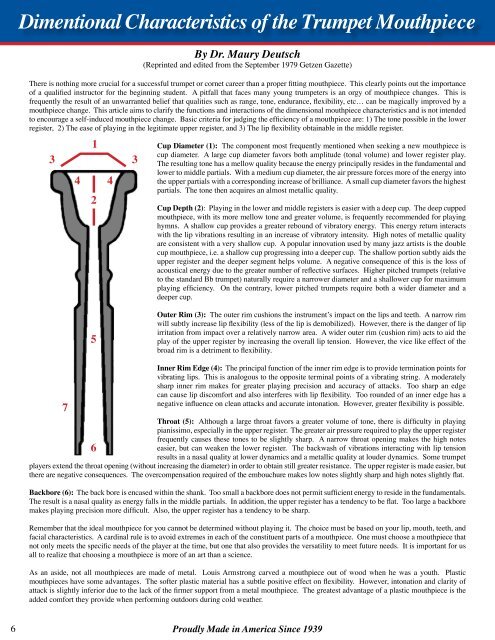Breaking Up the “Boys Club” - Getzen
Breaking Up the “Boys Club” - Getzen
Breaking Up the “Boys Club” - Getzen
You also want an ePaper? Increase the reach of your titles
YUMPU automatically turns print PDFs into web optimized ePapers that Google loves.
6<br />
Dimentional Characteristics of <strong>the</strong> Trumpet Mouthpiece<br />
By Dr. Maury Deutsch<br />
(Reprinted and edited from <strong>the</strong> September 1979 <strong>Getzen</strong> Gazette)<br />
There is nothing more crucial for a successful trumpet or cornet career than a proper fitting mouthpiece. This clearly points out <strong>the</strong> importance<br />
of a qualified instructor for <strong>the</strong> beginning student. A pitfall that faces many young trumpeters is an orgy of mouthpiece changes. This is<br />
frequently <strong>the</strong> result of an unwarranted belief that qualities such as range, tone, endurance, flexibility, etc… can be magically improved by a<br />
mouthpiece change. This article aims to clarify <strong>the</strong> functions and interactions of <strong>the</strong> dimensional mouthpiece characteristics and is not intended<br />
to encourage a self-induced mouthpiece change. Basic criteria for judging <strong>the</strong> efficiency of a mouthpiece are: 1) The tone possible in <strong>the</strong> lower<br />
register, 2) The ease of playing in <strong>the</strong> legitimate upper register, and 3) The lip flexibility obtainable in <strong>the</strong> middle register.<br />
1<br />
3 3<br />
7<br />
4 4<br />
2<br />
5<br />
Cup Diameter (1): The component most frequently mentioned when seeking a new mouthpiece is<br />
cup diameter. A large cup diameter favors both amplitude (tonal volume) and lower register play.<br />
The resulting tone has a mellow quality because <strong>the</strong> energy principally resides in <strong>the</strong> fundamental and<br />
lower to middle partials. With a medium cup diameter, <strong>the</strong> air pressure forces more of <strong>the</strong> energy into<br />
<strong>the</strong> upper partials with a corresponding increase of brilliance. A small cup diameter favors <strong>the</strong> highest<br />
partials. The tone <strong>the</strong>n acquires an almost metallic quality.<br />
Cup Depth (2): Playing in <strong>the</strong> lower and middle registers is easier with a deep cup. The deep cupped<br />
mouthpiece, with its more mellow tone and greater volume, is frequently recommended for playing<br />
hymns. A shallow cup provides a greater rebound of vibratory energy. This energy return interacts<br />
with <strong>the</strong> lip vibrations resulting in an increase of vibratory intensity. High notes of metallic quality<br />
are consistent with a very shallow cup. A popular innovation used by many jazz artists is <strong>the</strong> double<br />
cup mouthpiece, i.e. a shallow cup progressing into a deeper cup. The shallow portion subtly aids <strong>the</strong><br />
upper register and <strong>the</strong> deeper segment helps volume. A negative consequence of this is <strong>the</strong> loss of<br />
acoustical energy due to <strong>the</strong> greater number of reflective surfaces. Higher pitched trumpets (relative<br />
to <strong>the</strong> standard Bb trumpet) naturally require a narrower diameter and a shallower cup for maximum<br />
playing efficiency. On <strong>the</strong> contrary, lower pitched trumpets require both a wider diameter and a<br />
deeper cup.<br />
Outer Rim (3): The outer rim cushions <strong>the</strong> instrument’s impact on <strong>the</strong> lips and teeth. A narrow rim<br />
will subtly increase lip flexibility (less of <strong>the</strong> lip is demobilized). However, <strong>the</strong>re is <strong>the</strong> danger of lip<br />
irritation from impact over a relatively narrow area. A wider outer rim (cushion rim) acts to aid <strong>the</strong><br />
play of <strong>the</strong> upper register by increasing <strong>the</strong> overall lip tension. However, <strong>the</strong> vice like effect of <strong>the</strong><br />
broad rim is a detriment to flexibility.<br />
Inner Rim Edge (4): The principal function of <strong>the</strong> inner rim edge is to provide termination points for<br />
vibrating lips. This is analogous to <strong>the</strong> opposite terminal points of a vibrating string. A moderately<br />
sharp inner rim makes for greater playing precision and accuracy of attacks. Too sharp an edge<br />
can cause lip discomfort and also interferes with lip flexibility. Too rounded of an inner edge has a<br />
negative influence on clean attacks and accurate intonation. However, greater flexibility is possible.<br />
Throat (5): Although a large throat favors a greater volume of tone, <strong>the</strong>re is difficulty in playing<br />
pianissimo, especially in <strong>the</strong> upper register. The greater air pressure required to play <strong>the</strong> upper register<br />
frequently causes <strong>the</strong>se tones to be slightly sharp. A narrow throat opening makes <strong>the</strong> high notes<br />
6<br />
easier, but can weaken <strong>the</strong> lower register. The backwash of vibrations interacting with lip tension<br />
results in a nasal quality at lower dynamics and a metallic quality at louder dynamics. Some trumpet<br />
players extend <strong>the</strong> throat opening (without increasing <strong>the</strong> diameter) in order to obtain still greater resistance. The upper register is made easier, but<br />
<strong>the</strong>re are negative consequences. The overcompensation required of <strong>the</strong> embouchure makes low notes slightly sharp and high notes slightly flat.<br />
Backbore (6): The back bore is encased within <strong>the</strong> shank. Too small a backbore does not permit sufficient energy to reside in <strong>the</strong> fundamentals.<br />
The result is a nasal quality as energy falls in <strong>the</strong> middle partials. In addition, <strong>the</strong> upper register has a tendency to be flat. Too large a backbore<br />
makes playing precision more difficult. Also, <strong>the</strong> upper register has a tendency to be sharp.<br />
Remember that <strong>the</strong> ideal mouthpiece for you cannot be determined without playing it. The choice must be based on your lip, mouth, teeth, and<br />
facial characteristics. A cardinal rule is to avoid extremes in each of <strong>the</strong> constituent parts of a mouthpiece. One must choose a mouthpiece that<br />
not only meets <strong>the</strong> specific needs of <strong>the</strong> player at <strong>the</strong> time, but one that also provides <strong>the</strong> versatility to meet future needs. It is important for us<br />
all to realize that choosing a mouthpiece is more of an art than a science.<br />
As an aside, not all mouthpieces are made of metal. Louis Armstrong carved a mouthpiece out of wood when he was a youth. Plastic<br />
mouthpieces have some advantages. The softer plastic material has a subtle positive effect on flexibility. However, intonation and clarity of<br />
attack is slightly inferior due to <strong>the</strong> lack of <strong>the</strong> firmer support from a metal mouthpiece. The greatest advantage of a plastic mouthpiece is <strong>the</strong><br />
added comfort <strong>the</strong>y provide when performing outdoors during cold wea<strong>the</strong>r.<br />
Proudly Made in America Since 1939



